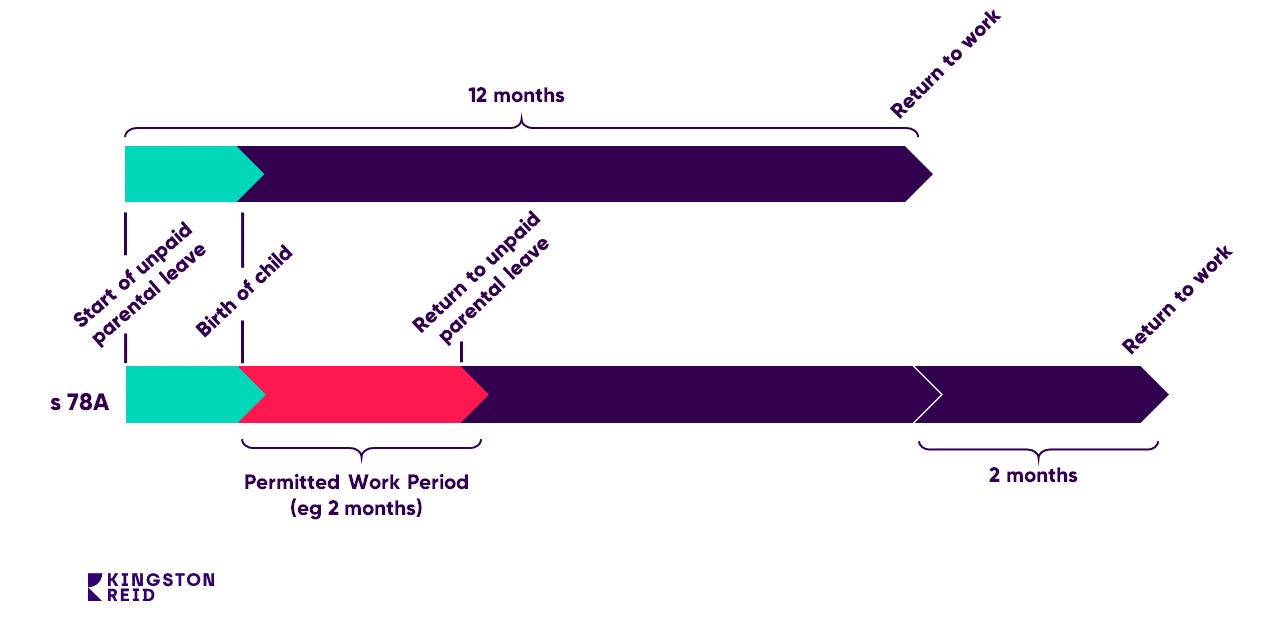In an important development for expecting parents and their employers, Parliament has passed legislation extending unpaid parental leave entitlements to parents of stillborn children or those who die during the first 24 months of life. The changes provide parents who would otherwise have been entitled to unpaid parental leave, with the same amount of parental leave in the event of a stillbirth. Changes to the requirements for how and when parental leave can be taken, and to the interaction between the NES and the government-funded Paid Parental Leave (PPL) scheme have also come into effect. Here’s what you need to know.
Leave entitlements for parents of a stillborn child or child who dies during their first 24 months
The legislative changes replace the previous s 77A of the Fair Work Act 2009 (Cth) (FW Act) that allowed an employer to cancel planned parental leave in the event of a stillbirth and direct the employee back to work with 6 weeks’ notice. The new s 77A provides those employees with an entitlement to 12 months’ unpaid parental leave and extinguishes the right for the employer to cancel that leave. The employee can still cancel planned parental leave and can return to the workplace with at least 4 weeks’ notice to the employer. The FW Act now defines a stillborn child as one whose gestation period was at least 20 weeks or who weighs at least 400 grams at delivery.
The relevant evidence requirements have also been amended to ensure that employers can require evidence that would satisfy a reasonable person that the new provisions regarding stillbirth or death of a child apply in the case of the relevant employee.
Employees on unpaid parental leave were also previously unable to access compassionate leave. They are now eligible to access 2 days paid compassionate leave in the event of a stillbirth of a child.
Permitted breaks in unpaid parental leave
As a general rule, employees are required to take unpaid parental leave in one block and not return to the workplace, apart from for the purpose of keeping in touch days, until they intend to do so permanently. In practice, this means that once an employee goes on parental leave, if their baby is born prematurely or requires hospitalisation, they can’t return to work even for a short period and then recommence unpaid parental leave once their baby is discharged. Whilst some employees in this situation may choose not to return to work during the period of hospitalisation, the result may be less time at home with their child after they are discharged.
The changes to the FW Act now provide for a new exception to that rule. The new s 78A provides that where a child is required to remain in hospital or is hospitalised immediately after birth, an employee who has given notice of taking unpaid parental leave, will have the option to return to the workplace while the child remains in hospital without breaking the continuity of their parental leave. This is to be known as a permitted work period. The end date of the unpaid parental leave can then be extended by the duration of the permitted work period.
Only one permitted work period will be allowed during unpaid parental leave, and the employer can require medical evidence of both the circumstances giving rise to the applicability of the section and of the employee’s fitness for work during the permitted work period.
The NES and PPL scheme
Finally, recent changes to the Paid Parental Leave Act 2010 (Cth) on 1 July 2020 mean that employees receiving the 18 weeks’ paid parental leave under that scheme can how take 12 weeks’ paid leave in one block and the remaining 6 weeks’ at any time within 24 months of the birth or adoption of the child. This could also be at a time after the employee returns to work. Whilst this flexibility has been introduced in respect of the PPL scheme, it has not previously been reflected in the unpaid entitlement under the NES. This meant that where an employee wished to access the PPL scheme after the first 12 months of unpaid leave, they were required to negotiate this time off with their employer, because the NES previously required that once an employee returns to work they would forfeit the remaining unpaid leave entitlement.
A new s 72A in the NES now mirrors the flexibility in the PPL scheme allowing employees to take up to 6 weeks of their unpaid parental leave at any time in the first 24 months after the birth of the child, even after a return to work. The period of unpaid leave being taken ‘flexibly’ or separately from the initial block of leave, can be taken in separate periods as short as a single day at a time. Employees wishing to use part of their unpaid parental leave flexibly will need to advise their employer of this when giving notice of their intention to take unpaid parental leave, unless the employer agrees to receive the notice at a later date.
Tips for employers
Employers should consider whether their parental leave policies require any amendment to reflect the above changes. In particular, query if exceptions to the requirement to take parental leave in a single block should be set out in your policy.
If you are in any doubt as to how these changes may affect your business, contact us at Kingston Reid to discuss.
Katie Sweatman
Partner
+61 3 9958 9605
[email protected]
Bronte Richardson
Lawyer
+61 2 9169 8418
[email protected]
